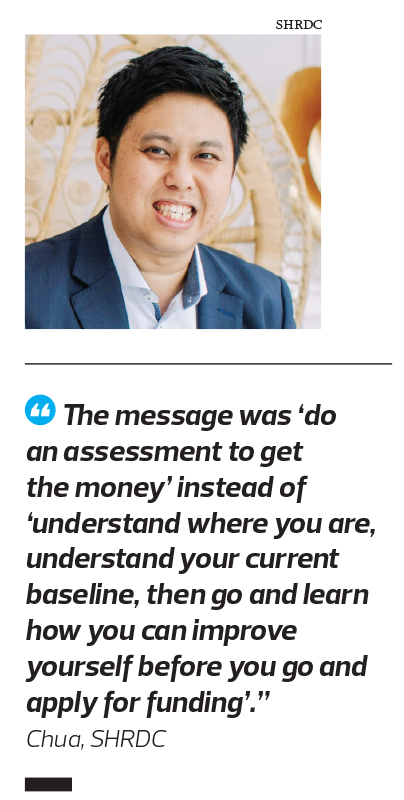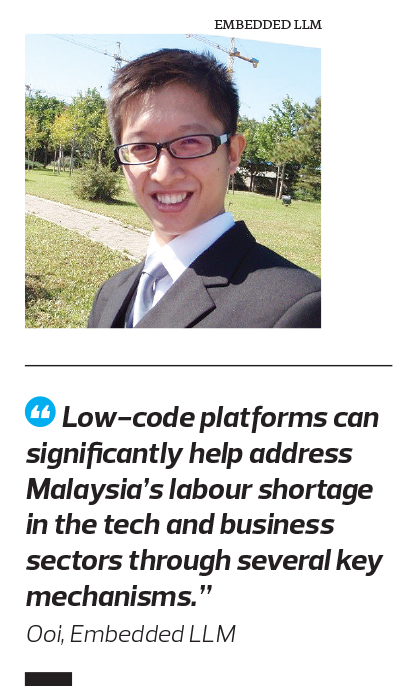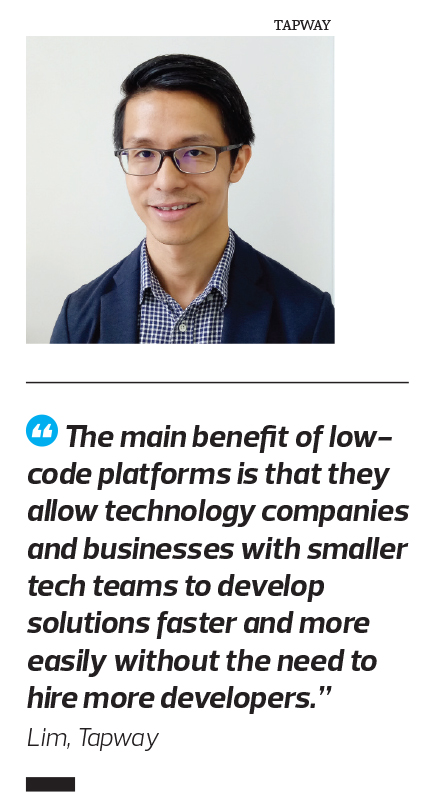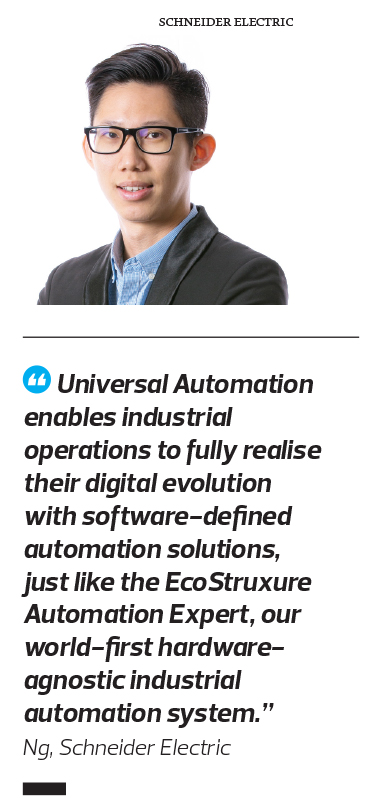
This article first appeared in Digital Edge, The Edge Malaysia Weekly on December 30, 2024 - January 12, 2025
Malaysia has long depended on low-skilled foreign labour to fill low-wage jobs that many locals avoid. These roles are often highly routine, and as the country seeks to reduce its reliance on foreign labour, automation is increasingly being seen as the key solution.
In 2022, the International Organisation for Migration estimated that there were 2.2 million migrant workers in Malaysia, forming a significant part of the 14.4 million labour force, primarily in manufacturing, construction, agriculture, services and plantations.
“As technology advances, policies like the Industry4wrd National Policy and New Industrial Master Plan (NIMP) are solving this reliance by filling this labour gap with machinery, making use of the rise of Industry 4.0 or Smart Factory technologies,” says Dr Chua Wen-Shyan, head of Malaysian Smart Factory 4.0 at the Selangor Human Resource Development Centre (SHRDC).
Manufacturers are increasingly adopting the Internet of Things (IoT), artificial intelligence (AI) and robotics to create more interconnected and intelligent systems that optimise resource management and enhance decision-making processes.
The Covid-19 pandemic significantly accelerated the digital transformation of businesses, propelling advancements by years, if not decades, Chua believes.
Since then, most manufacturing and logistics operations have embraced digitalisation. Additionally, many family-owned businesses are transitioning to the next generation, who are more inclined to adopt new technologies.
The SHRDC examines Malaysia’s labour shortage across both high-skilled and low-skilled sectors, exploring the root causes of this issue. The rise of the gig economy has drawn many workers away from traditional employment, but automation and technology present opportunities to reintegrate them into factories through more fulfilling and challenging roles.
While automation is often linked to job reduction, the reality can be quite the opposite. When factories adopt automation and digitalisation, they not only create new roles but also enhance job value. Positions that were once considered tedious can become innovative and appealing, offering competitive wages and revitalising the workforce.
And it seems to be working. While Chua could not provide official figures, SHRDC has observed a growing number of young talents entering not only manufacturing but also agricultural industries, particularly with companies perceived as forward-thinking.
Despite its advantages, automation in Malaysia’s manufacturing industry has yet to achieve widespread adoption. Chua explains that this is largely due to the nature of locally produced goods, which are often customised to client specifications. Instead of manufacturing 100,000 identical items, production typically involves only a few thousand at a time.
This low production volume makes it challenging to justify the cost of acquiring and implementing machines designed for mass production, as the returns may not appear as compelling.
“We can understand what the government is trying to do. They want to get local people to work in the factory. But when you do that without solving the problem of getting the local workforce back to the factory or even proper incentives for automation, [it creates] big challenges in the company trying to manage things right. So, they end up not being able to get enough workers and shut down,” says Chua.
As a result, SHRDC adopts a cautious approach when discussing transformation plans with companies, encouraging them to proceed only if they are genuinely prepared. Businesses are also urged to build in-house technical teams to manage the transition effectively.
Chua notes that initiatives and programmes, not only from SHRDC but also through NIMP, the New Malaysia Plan and others, play a crucial role in driving automation adoption. This shift is increasingly vital for factories, especially as government policies aim to make foreign labour more expensive and less accessible.
Rise of smart factories
Automation is adopting technologies like robots to remove the need for manual labour, while digitalisation is used to visualise the productivity of the company to analyse and improve performance.
For too many companies, the move to digitalisation is often hindered by the heavy costs and not fully understanding what it means to digitalise instead of just automate. Chua recalls times when a manufacturer he was in talks with had automated but not digitalised, and did not understand the difference between the two.
He gave an example of a factory that has 10 fully automated machines. “But how do we know these 10 machines are operating at the best efficiency, the most optimal rate? How do we see what’s the total number of outputs in a day, rejects, quality issues, downtime issues?”
Often once a company sees this value do they become more accepting of newer technologies, which SHRDC addresses through its initiatives to meet NIMP’s goal of having 3,000 smart factories in Malaysia by 2030.
Chua defines a smart factory as a robust digital factory that is highly intelligent and data-driven. In a smart factory, the entire manufacturing process is traceable from end to end, meaning the factory owner can see the entire production flow and visualise the data.
This means the entire factory is highly automated, with robots and machinery taking over much of the manufacturing process, with machines monitoring the entire line and providing real-time data that allows factory owners to review and revise things to increase efficiency.
So not only is the need for low-skilled workers like assembly line workers removed, but it also opens jobs for higher-skilled ones, like data analysts or engineers to monitor and maintain the system.
In a way, Chua sees NIMP and the push for smart factories as a rebranding of sorts for the government’s Industry 4.0 initiatives, addressing the issues it had during its implementation.
To him, the past implementation of Industry 4.0 policies by the government was very technology-focused. So, if a company wanted to digitalise they had to do a government readiness assessment and then ask government agencies for a grant.
“The message was ‘do an assessment to get the money’ instead of ‘understand where you are, understand your current baseline, then go and learn how you can improve yourself before you go and apply for funding’,” says Chua.
SHRDC has run many training programmes, worked with various universities and internship programmes and trained lecturers to spread the benefits and value of smart factories to increase adoption. Despite these efforts, he is not optimistic about meeting the NIMP goal of 3,000 smart factories.
“One year since the NIMP was launched and I think that, in my personal opinion, it’s been quiet. There’s not much talk about technology or smart factories in the past year,” he notes.
Instead, most of the discussions have been around sustainability efforts, with a lot of push from government sectors on environmental, social governance and social development goals.
Chua says this itself is not an issue, only that there is not a lot of time to reach the 3,000 smart factory goal within six years. So, the country has to move fast with a consolidated effort from all stakeholders to transform the industry, which he sees as unrealistic.
Instead, SHRDC is encouraging companies to take a standardised baseline assessment to fully understand where businesses are in their smart factory transformation journey. Once they have that baseline, they can then set more realistic numbers and set reasonable targets come 2030.
This had an interesting effect where some companies they reached out to, upon realising and hearing about NIMP, would respond with inquiries about their smart factory transformation plan and how realistic it is, which Chua notes is a great start.
“Interestingly they gave us a call and said, ‘I have a roadmap now. I want to share this with you, and you tell me whether I am dreaming or I am able to achieve it,’” he says.
Low-code platforms empowering the workforce
Another facet of SHRDC’s services is it supplies and networks companies with platforms that further help alleviate the reliance on large teams while empowering employees to accomplish tasks faster and more efficiently: low-code and no-code platforms.
Low-code platforms are digital platforms where employees can perform tasks usually done through coding, such as creating a website or software application, through intuitive drag-and-drop tools that require little to no coding knowledge.
This not only empowers existing employees but also reduces the need for large teams of those with coding knowledge, and some platform providers saw companies that adopt low-code platforms are more likely to create a workplace culture that attracts younger generations of employees.
“Low-code platforms can significantly help address Malaysia’s labour shortage in the tech and business sectors through several key mechanisms, such as the democratisation of technology development which enables non-technical business stakeholders to create AI solutions and bridges the gap between business needs and technical implementation,” says Ooi Ghee Leng, CEO of Embedded LLM (large language model).
According to Lim Chee How, CEO of low-code platform provider Tapway, the main benefit of low-code platforms is that they allow technology companies and businesses with smaller tech teams to develop solutions faster and more easily without the need to hire more developers.
Essentially, low-code and no-code platforms help democratise technology solutions and make them more affordable to the masses, allowing them to automate labour with technology solutions.
Tapway’s platform, SamurAI, is one example of this. It provides a no-code platform for companies to make their own Vision AI solution, an AI that can detect and analyse data from cameras. This reduces costs from outsourcing entire projects, while not outright removing the need for these high-skilled workers.
“The infrastructure and underlying logic of software development will still require in-depth expertise. That’s where the skilled technical professionals come in,” says Kien Yew Liang, founder and managing partner of Dallas Roboter.
Liang notes that while these platforms help with reducing costs and speeding up automation, it does not fully resolve labour shortages unless automation becomes a central business strategy.
Ooi adds, “The impact isn’t about addressing a labour shortage, as Malaysia has plenty of technical talent, but rather about enabling faster, more effective digital transformation by allowing business experts to directly implement solutions while making better use of existing technical talent.”
Technologies changing automation
These innovations in the labour force extend beyond empowering employees, they can transform the factories as a whole, making them more efficient and simpler for businesses to adopt.
Addressing the issue of integrating automation into legacy systems due to outdated software, Universal Automation offers a transformative approach to digital technology integration in manufacturing, using a modular, plug-and-produce software ecosystem, an approach Schneider Electric is championing.
Ng Wei Jie, business vice-president of industrial and process automation at Schneider Electric Malaysia, notes how through this, industrial companies can select the automation technology they need, matching applications into one seamless automation system built on the IEC 61499 standard, the international standard for these infrastructure systems.
“It enables industrial operations to fully realise their digital evolution with software-defined automation solutions, just like the EcoStruxure Automation Expert, our world-first hardware-agnostic industrial automation system,” he says.
On the other side, transforming entire factories at once, new technologies like AI has shown to be another proponent of change to address the challenges of low-skilled labour while drawing high-skilled ones into industries once thought unrelated.
In November, local AI company Airei opened Malaysia’s first AI-based palm oil mill at Minsawi Industries in Kuala Kangsar, Perak. Reporting a decrease in labour by about 30%, Airei removed routine jobs like an operator who opens and closes doors to place palm fruit on the mill conveyor belt.
While this partly affected some domestic jobs, it removed the need for jobs to be often filled by foreign workers.
The AI-based mill works by replacing those repetitive-task jobs with machinery. Doors and mechanics run automatically and are monitored using vision AI to dictate when to move the process along. Instead of relying on manual labour, the focus shifts to AI engineers who maintain and improve the system.
“We are trying to minimise those very basic kinds of jobs, and we are replacing them with AI. At the same time, for those guys who are no longer working, we are telling them to do other things, like taking up training to learn welding skills. We don’t want people to just sit down doing repetitive jobs. That’s what we are trying to eliminate,” says Airei CEO Surendran Kuranadan.
The biggest challenge when implementing this system was that you could not turn off the mill and install these systems, he says. His team had to install these technologies while the mill was still in operation, except for a seven-hour window on Sundays to ensure production was not hindered.
The other challenge is that this mill is the first of its kind. Much like smart factories, a lot of the plan moving forward is convincing factory owners of the value of this technology, and that mills no longer need to rely on labour for repetitive tasks.
This comes back to even the impetus of the entire AI-based mill project: addressing a problem that arose during the Covid-19 pandemic, when finding labour was difficult and the idea to create a mill less reliant on foreign labour was born.
With the introduction of advanced platforms like Universal Automation, AI-based mills and smart factories, there are signs of a transformative shift that emphasises a need for upskilling and reskilling of local talent to meet the demands of a more automated and digitally integrated manufacturing environment.
Save by subscribing to us for your print and/or digital copy.
P/S: The Edge is also available on Apple's App Store and Android's Google Play.
- TSMC could face US$1b fine or more from US probe — Reuters
- Massive US tariffs likely to neutralise ringgit's weakness as export aid, say economists
- Musk calls Navarro a ‘moron’ as Trump tariff spat gets messy
- AEON Credit, Matrix Concepts, Fajarbaru, S P Setia, Yong Tai, Taghill, LSH, KNM, Northern Solar, PetGas, Panasonic Malaysia, Subur Tiasa
- Asian stocks drop as Trump’s tariff deadline nears
- US slaps higher taxes on small parcels in tit-for-tat trade war
- Asian stocks drop as Trump’s tariff deadline nears
- SumiSaujana slumps on ACE Market, on course to be worst IPO debut
- Malaysian stocks broadly lower as Asian investors brace for Trump tariffs
- US tariffs, China slowdown cloud developing Asia's growth outlook, says ADB





